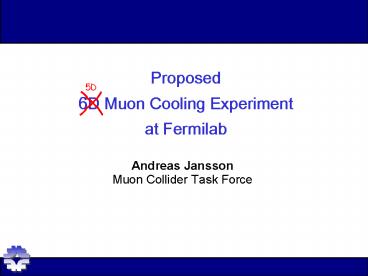Proposed 6D Muon Cooling Experiment at Fermilab - PowerPoint PPT Presentation
1 / 21
Title:
Proposed 6D Muon Cooling Experiment at Fermilab
Description:
Prepare a one year study plan to (a) evaluate the technical feasibility of the ... Detector development (eg SciFi in LHe) Coordinate with HCC design ... – PowerPoint PPT presentation
Number of Views:36
Avg rating:3.0/5.0
Title: Proposed 6D Muon Cooling Experiment at Fermilab
1
Proposed 6D Muon Cooling Experiment at Fermilab
- Andreas Jansson
- Muon Collider Task Force
2
MCTF charge
- i) Cooling Channel and Collider Design Concept.
- ii) Cooling Channel RD.
- Prepare a one year study plan to (a) evaluate
the technical feasibility of the components (rf
cavities, magnets, absorbers, etc) needed for a
muon collider class 6D cooling channel as
identified in i), (b) identify the technical
issues that must be addressed before a 6D cooling
channel could be built, and (c) formulate a plan
for the associated component RD and 6D cooling
tests that must be performed to establish basic
viability of the cooling channel. The study plan
should be documented in a short report in
September 2006. The results of the one year study
should be documented in a more detailed report in
September 2007.iii) Component Development and
Testing.
3
Helical Cooling Channel
4
Muon beam cooling experiment
- Can we test this with a beam?
- Would be complementary to MICE (single particle)!
- Cooling of a beam would be a more tangible result
than cooling of single particles. - Could potentially be done with simpler
instruments (beam profiles vs tracking
spectrometer). - Good case for doing it at Fermilab.
5
MTA properties
- 400MeV/c2 protons from linac
- Relatively tight space.
- Infrastructure available (eg cryo for HCC) ?
- High beam availability ?
- Expect total pi yield few percent, usable yield
of a few 10-5. Could get 107 - 108 muons per
pulse within the acceptance of the HCC ?
6
Muon Test Area
- Current RD focus at the MTA
- RF testing (805 and 201 MHz)
- High pressure H2 gas-filled RF
- LH2 Absorber tests
- Two parts of infrastructure yet to be completed
- Cryo Plant
- Proton beam Line
- Low-intensity
- High-intensity (part of MCTF)
7
MTA Hall
8
Conceptual experiment setup
Muon selection
Cooling channel (instrumented) matching section
Focusing
Pion decay channel
Beam
Pion selection
Target
Muon beam diagnostics (emittance and momentum
spread)
9
Required muon beam properties
Covariance matrix at beginning of HCC matching
section
- Angular momentum is much smaller than would be
generated by fringe field. - The beam should have canonical momentum
- Should be generated inside a solenoid
10
Target, pion capture and decay channel
- Aluminum target in 6T solenoid.
- Quadrupole decay channel (PAC01 design)
11
Simulation results
- MARS model of target and decay channel
- Simulations underway, expect results very soon
12
Preliminary optics design
Diagnostic sections
HCC
180º dispersion free bend
Decay channel
Uses BNL D2 quads Almost fits in MTA
13
Measurement system
- Six profile detectors at strategic locations
- Horizontal, vertical and 45 degree profiles
- 18 data points for 12 variables (10 beam moments
2 quad gradients)
14
Instrumentation
- Fiber tracker developed by PPD for MTEST
- Single MIP sensitivity depending on fiber size
and electronics - Can probably be used directly in beam lines
- May be modified for use in LHe?
15
Chromaticity issue
- Chromatic effects can spoil the measurement
- Possible solution reduce the momentum spread
- Do macro-particle experiment in the
longitudinal plane. Only need to control and
measure average momentum! - Need to design collimation system
Off-momentum beta functions
16
Hybrid 5D Cooling Experiment
Monchromatic beam
x
y
E
x
y
t
x
y
E
t
x
y
Beam
Beam
Macro-particle
17
Alternate Hybrid Cooling experiment
Pencil beam
x
y
E
x
y
t
x
y
E
t
x
y
Beam
Macro-particle
Macro-particle
18
Pencil beam experiment
- Easy to generate pencil beam with large momentum
spread. - Position and angle easy to control.
- Diagnostics is simpler (mainly beam positions
plus beam width in dispersive section) -gt Better
accuracy - Simpler and shorter beam line.
- Can measure transverse non-linearities.
19
Pencil beam experiment layout
Steering dipoles
Position and angle
Energy distribution
Emittance collimation
Momentum collimation
20
Current efforts
- Set up large scale G4BL simulation capability and
refine HCC simulations. - Simulate target and capture efficiency.
- Refine muon beamline design
- Detector development (eg SciFi in LHe)
- Coordinate with HCC design
- Think about extensions to the programme (e.g.
Design and test of HCC with RF)
21
Conclusions
- The possibility of testing the HCC at Fermilab is
being studied. - Looks feasible to do this at MTA.
- Raster scan with pencil beam seems to be the
preferred method. - Could be relatively simple and cheap .
- More detail will be worked out over the next
several months.































